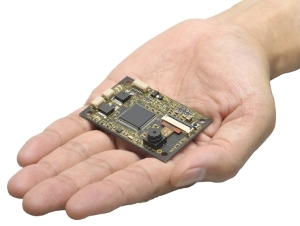OMRON Corporation today announced the development of its Human Vision Component (HVC), a new image sensing component that can be embedded in a variety of devices and equipment. The HVC incorporates ten algorithms from OKAO Vision and a camera module into a compact configuration.
 New Image Sensing Component for Easy Interpretation of People's Intentions and Conditions (Photo: Business Wire)
New Image Sensing Component for Easy Interpretation of People's Intentions and Conditions (Photo: Business Wire)
OKAO Vision is OMRON’s image sensing technology capable of recognizing the intentions and conditions of people through face recognition, estimation of facial expressions, age estimation, gaze estimation, hand detection, and other functions. Launch of the standard-type HVC is scheduled for December. From next year onward, OMRON plans to introduce a succession of application-specific HVC products, which will incorporate optimized hardware and optical systems to enable customized functions that meet the requirements of each specific industry.
By adding the new HVC line of components to conventionally available software products, OMRON expects to meet the market requirements for easy use of image information. This will further expand its image sensing business targeting human faces and motions. The new HVC will be unveiled at CEATEC Japan 2013 to be held October 1-5 in the Makuhari Messe fair site.
In recent times, image analysis technology targeting human faces and motions has been incorporated into more and more types of equipment. Examples include air conditioners capable of automatically adjusting the temperature to the level that people feel most comfortable; lighting products with efficient automatic control depending on the presence of people, their movements, or other conditions; automatic vending machines that suggest a product that matches the preference of a specific consumer; home appliances controllable via hand movements; robots that can react to the facial expressions of users; cars that prevent drowsy or inattentive driving by recognizing signs of fatigue in the driver’s face; and many more.
Still, conventional technology has limitations. When it comes to incorporating sophisticated algorithms into equipment, the CPU performance and memory size of the equipment are often insufficient. Extensive knowledge of software and hardware is required, and the development process is time-consuming. With OMRON’s HVC, all the processes up to image analysis are handled within the component itself. The user simply needs to mount the component on the equipment to obtain information on the conditions and intentions of people.
To date, OMRON has sold more than 500 million software licenses worldwide, mainly in the digital camera and mobile phone markets, which call for high-precision human face/motion sensing under varied conditions. Moreover, OMRON, as a sensor manufacturer, possesses cutting-edge optical design technology that supplements the processing of the image processing algorithms.
By combining these technologies, HVCs will enable high-precision interpretation of the faces and motions of people under various conditions in which the equipment is in use, whether indoor or outdoor. By offering these components, OMRON will strive for smoother communications and interactions between people and machines, while enabling a wide range of equipment to operate optimally in response to the intentions or conditions of users.
Features
1. People’s conditions recognizable simply by mounting an HVC on equipment
Regardless of the CPU performance of a customer’s equipment, simply mounting an HVC on the equipment enables the customer to obtain the results of advanced image processing as a sensor output.
2. Full range of functions
Ten different sensing functions are incorporated to recognize the intentions and conditions of people from a variety of perspectives.
Available functions are: 1) face detection, 2) human body detection, 3) gender estimation, 4) age estimation, 5) gaze estimation, 6) facial pose estimation, 7) face recognition, 8) estimation of facial expressions (satisfied, unsatisfied, five different expressions: happiness, surprise, anger, sadness, and neutral), 9) hand detection, and 10) blink estimation.
3. High precision
Accurate recognition of people’s conditions and intentions is enabled under a variety of situations in which a customer’s equipment is used.
Examples of Applications
Home appliances (air conditioners)
Optimal air conditioner control is possible through detection of the position and number of people in a room. Control can also vary depending on age and gender, or through the identification of a specific person.
Marketing research (POS registers and automatic venders)
Information on consumers who access these devices can be collected, including gender and age groups. HVC’s facial pose, gaze and expression estimation enables consumer preferences and purchasing behaviors to be detected.
Industrial equipment (food processing equipment)
Hands-free control of equipment is possible through the use of hand detection and gaze estimation.
Robotics (robotic pets)
Robots can react to the motions or facial expressions of users.
Security (access control systems)
Authorized persons who have registered their faces can enter or exit a room without using a card or key.
Specifications
Size: 60 mm x 40 mm
Power Voltage: 5 V
Input/Output Interface: UART 3.3 V
- Specifications are subject to change without notice.
- OKAO Vision and OKAO are registered trademarks or trademarks of OMRON Corporation in Japan and other countries.
- Other product and service names are registered trademarks or trademarks of respective owners.
For more information regarding HVC, visit: https://components.omron.com/us-en/